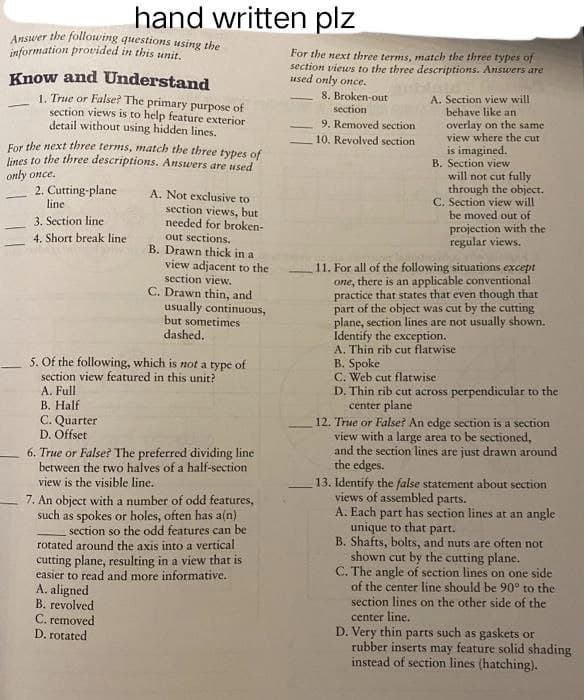Know and Understand 1. True or False? The primary purpose of section views is to help feature exterior detail without using hidden lines.
Know and Understand 1. True or False? The primary purpose of section views is to help feature exterior detail without using hidden lines.
Elements Of Electromagnetics
7th Edition
ISBN:9780190698614
Author:Sadiku, Matthew N. O.
Publisher:Sadiku, Matthew N. O.
ChapterMA: Math Assessment
Section: Chapter Questions
Problem 1.1MA
Related questions
Question
100%

Transcribed Image Text:hand written plz
Answer the following questions using the
information provided in this unit.
Know and Understand
1. True or False? The primary purpose of
section views is to help feature exterior
detail without using hidden lines.
For the next three terms, match the three types of
lines to the three descriptions. Answers are used
only once.
2. Cutting-plane
line
3. Section line
4. Short break line
A. Not exclusive to
section views, but
needed for broken-
out sections.
B. Drawn thick in a
view adjacent to the
section view.
C. Drawn thin, and
usually continuous,
but sometimes
dashed.
5. Of the following, which is not a type of
section view featured in this unit?
A. Full
B. Half
C. Quarter
D. Offset
6. True or False? The preferred dividing line
between the two halves of a half-section
view is the visible line.
7. An object with a number of odd features,
such as spokes or holes, often has a(n)
section so the odd features can be
rotated around the axis into a vertical
cutting plane, resulting in a view that is
easier to read and more informative.
A. aligned
B. revolved
C. removed
D. rotated
For the next three terms, match the three types of
section views to the three descriptions. Answers are
used only once.
8. Broken-out
section
9. Removed section
10. Revolved section
A. Section view will
behave like an
overlay on the same
view where the cut
is imagined.
B. Section view
will not cut fully
through the object.
C. Section view will
be moved out of
projection with the
regular views.
11. For all of the following situations except
one, there is an applicable conventional
practice that states that even though that
part of the object was cut by the cutting
plane, section lines are not usually shown.
Identify the exception.
A. Thin rib cut flatwise
B. Spoke
C. Web cut flatwise
D. Thin rib cut across perpendicular to the
center plane
12. True or False? An edge section is a section
view with a large area to be sectioned,
and the section lines are just drawn around
the edges.
13. Identify the false statement about section
views of assembled parts.
A. Each part has section lines at an angle
unique to that t part.
B. Shafts, bolts, and nuts are often not
shown cut by the cutting plane.
C. The angle of section lines on one side
of the center line should be 90° to the
section lines on the other side of the
center line.
D. Very thin parts such as gaskets or
rubber inserts may feature solid shading
instead of section lines (hatching).
Expert Solution
This question has been solved!
Explore an expertly crafted, step-by-step solution for a thorough understanding of key concepts.
This is a popular solution!
Trending now
This is a popular solution!
Step by step
Solved in 2 steps

Follow-up Questions
Read through expert solutions to related follow-up questions below.
Knowledge Booster
Learn more about
Need a deep-dive on the concept behind this application? Look no further. Learn more about this topic, mechanical-engineering and related others by exploring similar questions and additional content below.Recommended textbooks for you

Elements Of Electromagnetics
Mechanical Engineering
ISBN:
9780190698614
Author:
Sadiku, Matthew N. O.
Publisher:
Oxford University Press

Mechanics of Materials (10th Edition)
Mechanical Engineering
ISBN:
9780134319650
Author:
Russell C. Hibbeler
Publisher:
PEARSON

Thermodynamics: An Engineering Approach
Mechanical Engineering
ISBN:
9781259822674
Author:
Yunus A. Cengel Dr., Michael A. Boles
Publisher:
McGraw-Hill Education

Elements Of Electromagnetics
Mechanical Engineering
ISBN:
9780190698614
Author:
Sadiku, Matthew N. O.
Publisher:
Oxford University Press

Mechanics of Materials (10th Edition)
Mechanical Engineering
ISBN:
9780134319650
Author:
Russell C. Hibbeler
Publisher:
PEARSON

Thermodynamics: An Engineering Approach
Mechanical Engineering
ISBN:
9781259822674
Author:
Yunus A. Cengel Dr., Michael A. Boles
Publisher:
McGraw-Hill Education

Control Systems Engineering
Mechanical Engineering
ISBN:
9781118170519
Author:
Norman S. Nise
Publisher:
WILEY

Mechanics of Materials (MindTap Course List)
Mechanical Engineering
ISBN:
9781337093347
Author:
Barry J. Goodno, James M. Gere
Publisher:
Cengage Learning

Engineering Mechanics: Statics
Mechanical Engineering
ISBN:
9781118807330
Author:
James L. Meriam, L. G. Kraige, J. N. Bolton
Publisher:
WILEY